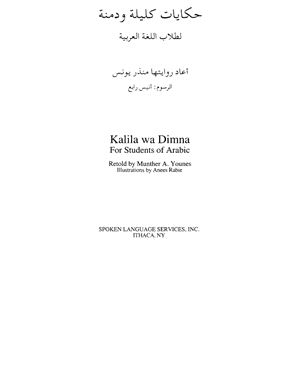Publisher: Spoken Language Services.
Publication date: 2001.
Number of pages: 214.
Format / Quality: pdf (excellent) + mp3 (excellent).
Spoken Language Services, Inc. announces the publication of Tales from Kalila wa Dimna for Students of Arabic by Munther A. Younes. This is an expanded version of Tales from Kalila wa Dimna: An Arabic Reader, published by Yale University Press in 1989.
Kalila wa Dimna, a well-known Arabic literary classic, on which the present volume is based, is an eighth-century translation of a collection of fables about people and animals that has long been enjoyed by Arab children and adults alike. In this illustrated rendition, Younes retells these fables in simplified language for intermediate and advanced students of Arabic. Each story is accompanied by an illustration and a set of activities geared towards enhancing the student’s reading and listening comprehension as well as the individual’s speaking and writing skills.
The book can be used in a classroom or for independent study. The three CD’s that accompany it include the texts of the stories read by the author. A comprehensive glossary at the end of the book includes all the words that were judged to be difficult or new for the intermediate-level student.
The book is particularly effective as a vocabulary-building tool, as the stories focus on key themes and a limited set of characters or character types. Consequently, much of the vocabulary recycles from one story to another, facilitating acquisition and active use.
The material aims to build the student’s confidence with the language. The comfortable presence of a context and a story line promotes comprehension; the stories are much easier to understand than groups of isolated sentences or descriptive passages.
As students read or listen to a story, they can predict or guess the meaning of unfamiliar words and structures.
As students venture to speak the language, they can imitate the story’s clear, thematic structure (a beginning, an end, and a defined plot), and its use simpler perfect form of Arabic verbs. This encourages a dynamic speaking experience that is more manageable than other types of speaking exercises,
At the intermediate or lower intermediate level, the student’s command of the language is still limited and the author designed the Kalila wa Dimna text and audio to increase their Arabic language skills with the right mixture of challenge and encouragement.
Five of the forty-six stories in the book are given in their original form, as they appear in unedited versions of Kalila wa Dimna. The intent is to give advanced students a feel for Classical Arabic and the ways in which it differs from Mode Standard Arabic. In two of the five stories, a simplified version appears along with the unedited version to invite critical thinking by the student.
Munther Younes is Senior Lecturer in Arabic language and linguistics at Coell University. His other publications include Elementary Arabic: An Integrated Approach and Intermediate Arabic: An Integrated Approach, both published by Yale University Press.
Publication date: 2001.
Number of pages: 214.
Format / Quality: pdf (excellent) + mp3 (excellent).
Spoken Language Services, Inc. announces the publication of Tales from Kalila wa Dimna for Students of Arabic by Munther A. Younes. This is an expanded version of Tales from Kalila wa Dimna: An Arabic Reader, published by Yale University Press in 1989.
Kalila wa Dimna, a well-known Arabic literary classic, on which the present volume is based, is an eighth-century translation of a collection of fables about people and animals that has long been enjoyed by Arab children and adults alike. In this illustrated rendition, Younes retells these fables in simplified language for intermediate and advanced students of Arabic. Each story is accompanied by an illustration and a set of activities geared towards enhancing the student’s reading and listening comprehension as well as the individual’s speaking and writing skills.
The book can be used in a classroom or for independent study. The three CD’s that accompany it include the texts of the stories read by the author. A comprehensive glossary at the end of the book includes all the words that were judged to be difficult or new for the intermediate-level student.
The book is particularly effective as a vocabulary-building tool, as the stories focus on key themes and a limited set of characters or character types. Consequently, much of the vocabulary recycles from one story to another, facilitating acquisition and active use.
The material aims to build the student’s confidence with the language. The comfortable presence of a context and a story line promotes comprehension; the stories are much easier to understand than groups of isolated sentences or descriptive passages.
As students read or listen to a story, they can predict or guess the meaning of unfamiliar words and structures.
As students venture to speak the language, they can imitate the story’s clear, thematic structure (a beginning, an end, and a defined plot), and its use simpler perfect form of Arabic verbs. This encourages a dynamic speaking experience that is more manageable than other types of speaking exercises,
At the intermediate or lower intermediate level, the student’s command of the language is still limited and the author designed the Kalila wa Dimna text and audio to increase their Arabic language skills with the right mixture of challenge and encouragement.
Five of the forty-six stories in the book are given in their original form, as they appear in unedited versions of Kalila wa Dimna. The intent is to give advanced students a feel for Classical Arabic and the ways in which it differs from Mode Standard Arabic. In two of the five stories, a simplified version appears along with the unedited version to invite critical thinking by the student.
Munther Younes is Senior Lecturer in Arabic language and linguistics at Coell University. His other publications include Elementary Arabic: An Integrated Approach and Intermediate Arabic: An Integrated Approach, both published by Yale University Press.

